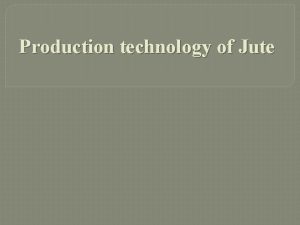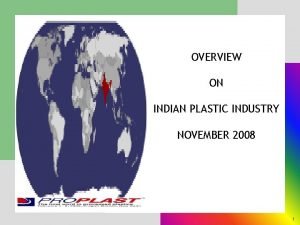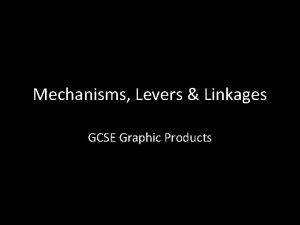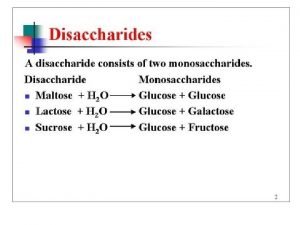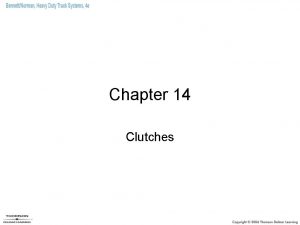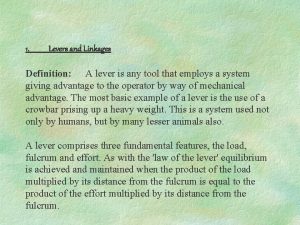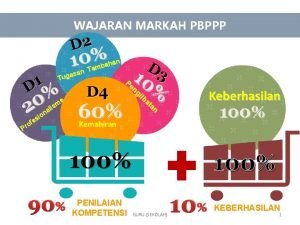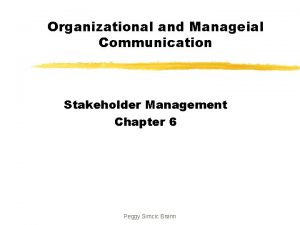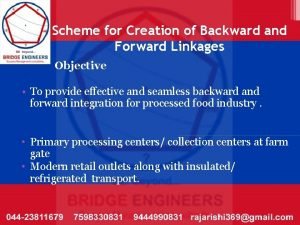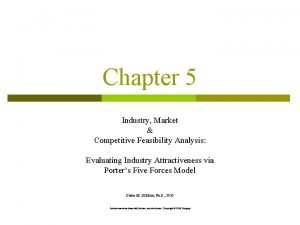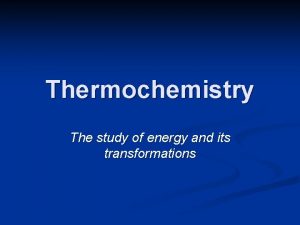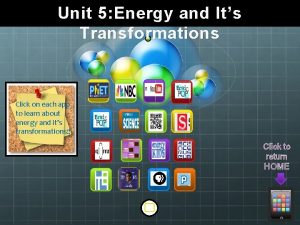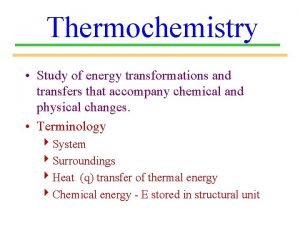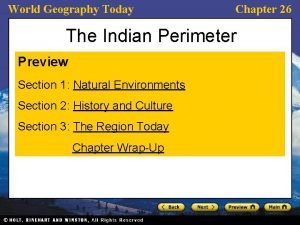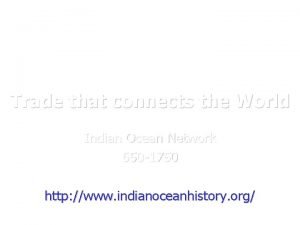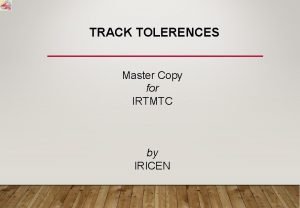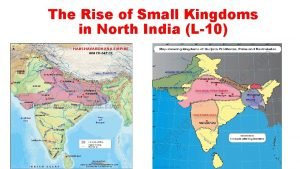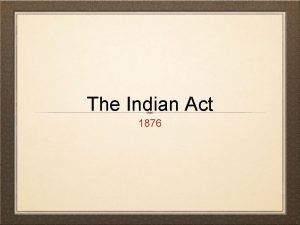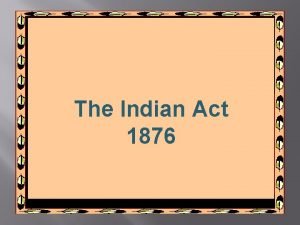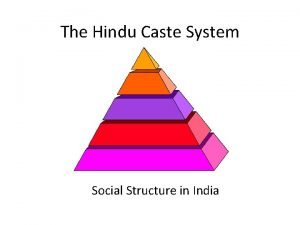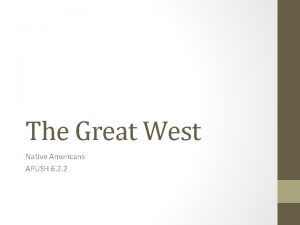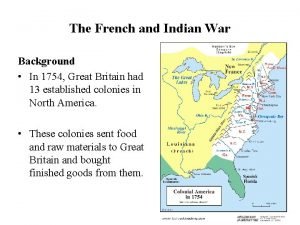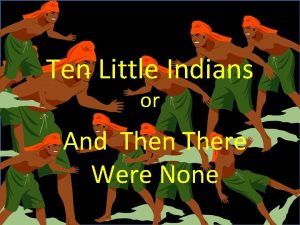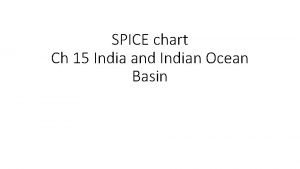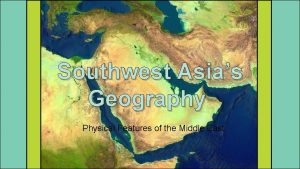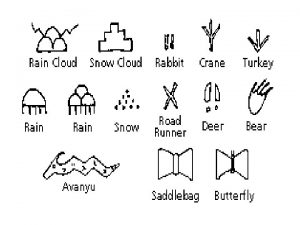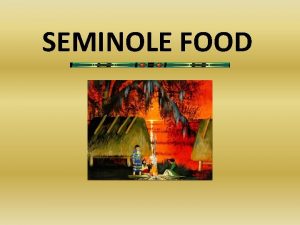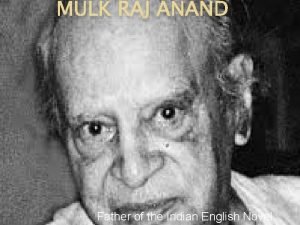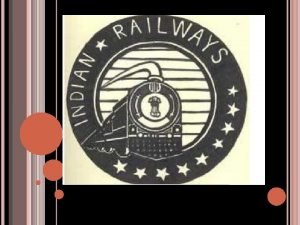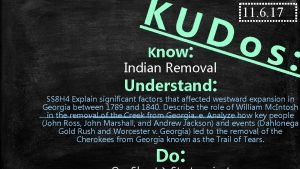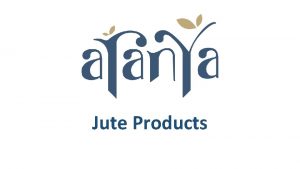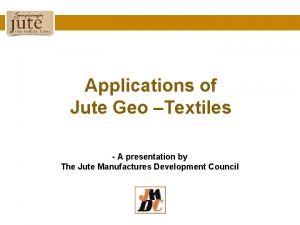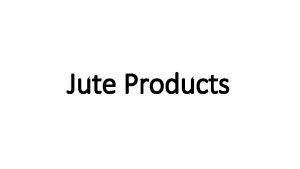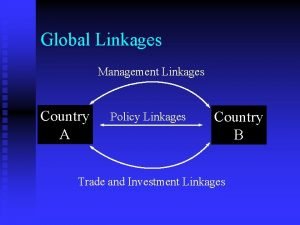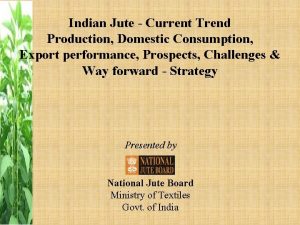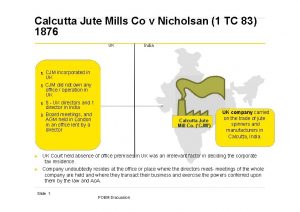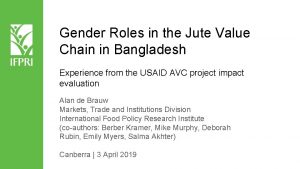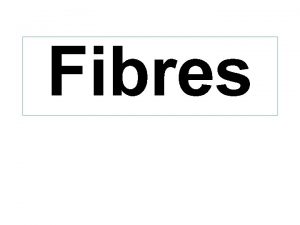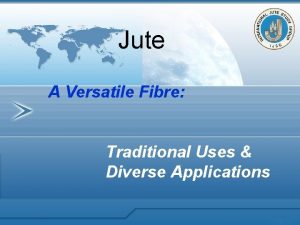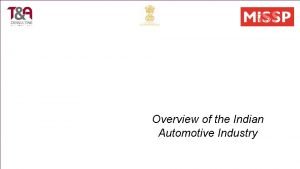Study Assessment of Indian Jute Industry its linkages






































































- Slides: 70

Study Assessment of Indian Jute Industry & its linkages with Global Value Chain Textiles Committee Govt. of India, Ministry of Textiles

Structure • Introduction, Objectives and Methodology • Jute Industry in the Global Trade • Jute Industry in India • Value Chain of the Jute industry of India and its linkage • Conclusion and Suggestive measures for strengthening the jute Textile industry

Introduction • Jute textile industry plays an important role in India’s economy in terms of generation of employment and income and augmenting national output of the sector. • The industry provides direct employment to 0. 37 million workers in organized mills and in diversified units including tertiary sector and allied activities and supports the livelihood of around 4. 0 million farm families. • In addition, large number of persons are engaged in trading of jute and jute products and other service activities. • India is the largest manufacturers of jute textiles followed by Bangladesh and Bangladesh out of the global production of about 3. 30 Million Tonnes per Annum.

Objectives & To. Rs Of the Study Main Objectives of the Study are : • Map different players involved in the Indian Jute Industry, their roles and issues and challenges they face, using a value chain approach. • Provide an overview of current situation and future directions of Jute natural fibre in India with special reference to agro-textiles industry linkages. • Discuss effective participation of Indian jute industry in Global Value Chain (GVC) and highlight challenges, constraints and barriers faced in connecting, moving up and establishing production and service value chains and analyze how these constraints are being addressed. • Identify public and private actions along value chain that can promote sustainability (economic/social/environmental) within Jute value chain. • Make policy recommendations on the way forward to sustain product and market diversification in the industry and strengthen linkages with the GVC.

Methodology Secondary Research • • • Comprehensive database on Jute mills, JDP manufacturing units, jute traders, farmers or farmers’ association, input suppliers, exporters, importers, buying agents etc of jute and jute products prepared based on secondary data. Global Trade in Jute was collected from various sources including existing data bases of WITs, ITC Trade Map, FAO, O/o Jute Commissioner, NJB, etc. Appropriate econometric tools like Export Similarity Index (ESI), Revealed Comparative Advantage (RCA) and Export Potential Indicator have been used to ascertain the Competitiveness of the jute textile products at 6 digit HS line basis keeping the global trade and competing countries position in mind. – RCA: The RCA is used in international economics for calculating the relative advantage or disadvantage of a certain country in certain class of goods or services as evidenced by trade flows. – – where X represents exports, i is a country, j is a commodity (or industry), t is a set of commodities (or industries), and n is a set of countries. ESI : ESI is intended to measure the similarity of exports among the countries in the destination market (Finger and Kreinin (1979) and is given by, where ESI(ab, c) refers the ESI of countries a and b in the common market (c); Xj(a, c) refers the exports of product j from country a to country c, and Xj(b, c) refers the exports of product j from country b to country c. ΣX(a, c) and ΣX(b, c) are total exports of country a and b to country c, respectively.

Methodology Primary Survey: • Development of Study Instruments: Taking cue from desk research the structured questionnaires, in-depth discussion guides, etc. were developed in consultation of the National Jute Board and other key actors of the sector. • Different Questionnaires are developed for collection of data from : • Input suppliers and Farmers. • Traders and intermediaries of Jute Fibres • Jute manufacturers like Yarns, Hessian Cloths, etc • Trades of Jute products • Manufacturers of Jute diversified products including Agro Textiles • The questionnaires were also pretested at unit level and appropriate modification were also made keeping the objectives in mind.

Methodology Primary Survey: Sample size enumerated for the purpose Stakeholders in Value Chain Input Suppliers/farmers Jute Textiles manufacturers in organised sector Grading & Trading Jute Diversified Product (JDP) manufacturers Buying Agents Retailers/ Wholesalers Jute Textile Exporters/Importers Units Covered 72 25 47 51 04 18 06 Jute textile producing states covered for the purpose are 1. East Zone: West Bengal, Assam, Odisha 2. South Zone: Andhra Pradesh, Telengana, Tamil Nadu, Kerala, Pondicherry, Karnataka. 3. North Zone: Haryana, Rajasthan, New Delhi, Uttar Pradesh 4. West Zone: Gujarat and Maharashtra

Key Stakeholders Covered • Input Suppliers & farmers • Jute textile manufacturers including spinning, weaving, processing, manufacturers of the diversified products, etc • Grading & Trading Mechanism • Jute Textile Exporters/importers • Buying Agents/retailers • Developmental agencies including state and central govt. organisations working for the development of the sector. • The Centre of Excellence of the Govt. for Agro-textiles and Geotextiles.

Value Chain Approach for GVC • Value Chain Analyses (VCA) Consists of two inter-linked components o Chain Analyses (Use information from key actors and firm-level data to map the value-chain and analyse systematic constraints in the chain to competing in high potential market) o The analyses has been carried out for the key actors in the jute textile value chain starting from input suppliers & farmers to the domestic and international market. o The existing and potential international Market for the jute textiles have taken into consideration.

Value Chain Approach-II

Mapping Global Value Chain & Competitiveness of Jute

Global Production of Raw Jute World Production of Raw Jute ('000 MT) 2690 2008 2829 2010 3454 2012 3396 2014 3311 2016 3531 2017 Uzbekistan, 0. 46% China, 0. 85% Row, 0. 30% Bangladesh, 42. 38 India, 55. 69% Raw Jute cultivation is mostly concentrated in South Asian region mainly India, Bangladesh, Nepal besides China, Uzbekistan etc • Global production of raw jute has recorded a moderate growth of 2. 76% during the last ten years. • India is the top producer of Jute in the world with 55. 69 % share followed by Bangladesh with 42. 38 %, China with 0. 85%, Uzbekistan with 0. 46% and Nepal with 0. 33%. The production has recorded a positive trend during 2016 and 2017. 3618 2018 (E) Share in Jute Production ('000 tonnes) Nepal, 0. 33% • •

Area and Productivity of Raw Jute • Around 52% of the world area under cultivation is in India followed by Bangladesh with 42%. • The production of jute in India and Bangladesh is 97% as compared to 94% of the cultivable area. • Yield per hectare is increasing at a CAGR of 0. 81% during the last five years Yield/Hectare (in MT) 2020 (E) 2. 28 2019 (E) 2. 27 2018 (E) 2. 27 2017 2. 21 2014 2012 2. 36 2. 16 2010 2008 2. 31 2. 15 1253 1225 2008 2010 Ro. W, 6. 63 0. 45% 2. 25 2015 1596 2012 1437 1470 1532 1591 2014 2016 2017 2018 (E) Share in Area under Cultivation ('000 Hectares) 2. 31 2016 Area under Jute Cultivation ('000 Ha) Nepal, 8. 01 ( 0. 55%) China, 12. 00 (0. 82%) India, 765. 11 (52. 07%) Bangladesh, 678. 68 (46. 12%)

Global Export of Jute Textiles Top Exporters of Jute textiles in world Global Export of Jute ($ Bn) 1. 27 1. 36 CAGR: 6. 29% 1. 18 1. 36 1. 43 0. 78 2008 2010 2012 2014 2016 2017 60% 50% 40% 30% 20% 10% 0% -10% -20% (AGR in %) 1. 6 1. 4 1. 2 1. 0 0. 8 0. 6 0. 4 0. 2 0. 0 Tanzania 1. 46% Myanmar 2. UK, 1. 90% 15% Ro. W, 8. 36% B'desh, 65. 71% Nepal, 3. 15% India, 17. 0% • Global export in Jute textiles has recorded CAGR of 6. 29% during last 10 years • The global export of jute textiles is US$ 1. 43 Bn in 2017 as compared to US$ 0. 78 Bn in 2008. • Bangladesh has dominated the export market with export of US$ 941. 36 million of jute textiles in 2017 with share of 65. 71%, followed by India with US$ 243. 55 million with share of 17%. • The countries like UK, Myanmar are also making their presence felt. While UK’s export is guided by value added product, other countries are mostly presence in both traditional and value added products.

Global Export of Jute Top Exporter in Jute ($ Mn) Exporters • • Bangladesh India Nepal Myanmar UK Tanzania Ro. W World 2008 2011 2014 2017 423. 70 226. 62 0. 11 0. 49 3. 45 0. 92 99. 72 778. 48 935. 51 380. 17 42. 48 0. 73 5. 74 12. 73 116. 32 1509. 87 722. 74 225. 16 36. 20 0. 54 13. 51 28. 23 136. 82 1179. 88 941. 36 243. 55 45. 14 30. 78 27. 29 20. 91 110. 04 1432. 62 Share 65. 71 17. 00 3. 15 2. 15 1. 90 1. 46 7. 68 100. 0 CAGR (200817) 8. 31 0. 72 82. 15 51. 21 22. 99 36. 72 0. 99 6. 29 In growth term, major gainer is Nepal (82. 15%), whose export share has increased substantially followed by Myanmar (51. 21%), Tanzania (36. 72%) and UK (22. 99%). The surge in export of these countries may be one of reason for decline in India’s export to world.

Global Import of Jute • Among the top importers, Turkey is major importer of Jute and import about $272. 67 million with share of 19. 18% followed by India $170. 44 million (11. 98%), China $131. 66 million (9. 26%), Sudan $ 82. 57 (5. 81%) and USA $64. 42 million (4. 53%) during 2017. • India is largest Jute producer and second largest importer. • The Unit Value Realisation (UVR) is highest in Iran, USA, India, Ghana and Sudan. These markets are providing better realisation than others and have high potential for higher value addition and greater realisation. Top Importer in Jute ($ Mn) Importers 2008 2011 2014 2017 Turkey India China Sudan USA Iran Pakistan Ghana Côte d'Ivoire Indonesia Ro. W World 121. 92 114. 80 49. 40 0. 71 47. 61 49. 09 63. 85 12. 15 10. 42 19. 99 542. 00 1031. 23 201. 70 229. 33 122. 58 39. 15 59. 02 70. 20 70. 85 36. 53 9. 57 30. 03 708. 99 1538. 80 212. 21 152. 20 112. 06 0. 00 64. 70 44. 33 42. 90 0. 00 17. 58 28. 83 483. 60 1158. 40 272. 67 170. 44 131. 66 82. 57 64. 42 55. 61 55. 53 38. 81 38. 19 32. 90 478. 85 1421. 66 Share 19. 18 11. 98 9. 26 5. 81 4. 53 3. 91 2. 73 2. 69 2. 31 33. 68 100. 0 CAGR (2008 -17) UVR (US$/Kg) 8. 38 4. 04 10. 30 60. 88 3. 07 1. 25 -1. 39 12. 32 13. 87 5. 11 -1. 23 3. 26 1. 20 1. 80 0. 54 1. 41 2. 27 2. 63 1. 23 1. 71 1. 32 1. 05 1. 77

Product wise Jute Export • Following 7 products at 6 -digit HS level are mostly exported Jute products in the global market: – Single Yarn (530710), – Sacks & bags, for packing of goods, of jute or of other textile bast fibres (630510) – Yarn of jute or of other textile bast fibres, multiple (folded) or cabled (530720) – Woven fabrics of jute or of other textile bast fibres, unbleached (531010) – Jute and other textile bast fibres, raw or retted (530310) – Woven fabrics of jute or of other textile bast fibres, other unbleached (531090) – Jute and other textile bast fib, not spun, nes; tow and waste of these fibres (530390) • There about 54 products at 8 -digit HS level. As information for all the nations is available at 6 digit, the analysis in this section is done at 6 -digit.

Top Products of Exports • Yarn of jute or of other textile bast fibres, single (530710) is the top exported product of jute in world with share of 29. 82%. • Bangladesh is top exporter of this product and contributed about 97. 97% share of total global export in product. India is at 4 th position with share of 0. 27%. • Similarly the second most exported product is Sacks & bags, for packing of goods, of jute or of other textile bast fibres (630510) with share of 26. 18% in world. • India is top exporter of this product with share of 32. 51% followed by Bangladesh with share of 31. 77%.

Global Trade Scenario of Jute Top Exporters of Jute in world 2017 UK 1. 92% Myanmar Nepal 2. 17% 3. 18% India 17. 16% Tanzania 1. 47% Top Importers of Jute in World (2017) Ro. W 7. 75% Ro. W 33. 68% Bangladesh 66. 34% • Bangladesh is the largest exporter with share of 66. 34% • India is the second largest exporter with share of 17. 16% Indonesia 2. 31% Côte d'Ivoire 2. 69% Ghana 2. 73% Turkey 19. 18% India 11. 99% China 9. 26% Sudan Pakistan Iran USA 5. 81% 3. 91%4. 00% • Turkey is the major importer with a share of 19. 18% • India is the second major importer with a share of 11. 99% • EU has also emerged as a significant market during last five years and its import is growing due to demand for eco friendly products.

Comparative Advantage of Major Players in Global Market • RCA indicates the product level strength of exporting country on global market. Major Players Bangladesh India Nepal Myanmar UK Tanzania China Belgium • • • Products having Comparative Advantage in Global Market 1) Yarn of jute or of other textile bast fibres, single (530710) 2) Jute and other textile bast fibres, raw or retted (530310) 3) Yarn of jute or of other textile bast fibres, multiple (folded) or cabled (530720) 1) Woven fabrics of jute or of other textile bast fibres, unbleached (531010) 2) Sacks & bags, for packing of goods, of jute or other textile bast fibres (630510) 1) Woven fabrics of jute or of other textile bast fibres, o/t bleached, dyed (531090), 2) Sacks & bags, for packing of goods, of jute or of other textile bast fibres (630510) 1) Woven fabrics of jute or of other textile bast fibres, dyed (531090) 2) Sacks & bags, for packing of goods, of jute or of other textile bast fibres (630510) 1) Jute and other textile bast fibres, raw or retted (530310) 1) Woven fabrics of jute or of other textile bast fibres, unbleached (531010), 2) Woven fabrics of jute or of other textile bast fibres, o/t unbleached (531090), 3) Sacks & bags, for packing of goods, of jute or other textile bast fibres (630510) 1) Jute and other textile bast fibres, processed but not spun; tow and waste of such fibres (530390) 2) Multiple "folded" or cabled yarn of jute or of other textile bast fibres (530720) 3) Woven fabrics of jute or of other textile bast fibres, o/t unbleached (531090) Bangladesh is enjoying comparative advantage in three products, while India maintains advantage in 2 products. China is also emerging as competitor to India on woven fabrics and sacks & bags for packing goods Nepal’s presence in the same products in the global market is also equally good.

Export Similarity Index of Major Players in Jute Exports to world • Export Similarity index used to find product level competing interests of countries. • India is competing with all countries in almost all product lines, Bangladesh’s product lines are mostly experiencing competition from Belgium (57. 85%), China & India. The diverse product matrix of Bangladesh may be one of the reason for it. Major Players Bangladesh India Nepal Myanmar UK Tanzania Kenya Côte d'Ivoire China Belgium B’desh India 32. 63 Nepal Myanmar 19. 31 50. 92 10. 49 37. 44 41. 87 32. 63 19. 31 50. 92 10. 49 37. 44 41. 87 18. 16 52. 28 60. 28 18. 65 5. 1 2. 67 30. 66 16. 71 12. 89 14. 03 48. 22 54. 78 37. 16 75. 19 64. 83 57. 85 57. 52 42. 41 UK Tanzania 18. 16 52. 28 60. 28 72. 7 5. 83 1. 58 25. 36 12. 92 75. 09 91. 79 37. 19 51. 46 33. 21 42. 12 18. 65 5. 1 2. 67 5. 83 1. 58 43. 47 0. 17 3. 81 24. 44 Kenya 30. 66 16. 71 12. 89 25. 36 12. 92 43. 47 11. 84 14. 03 38. 53 Côte China Belgium d'Ivoire 14. 03 37. 16 57. 85 48. 22 75. 19 57. 52 54. 78 64. 83 42. 41 75. 09 37. 19 33. 21 91. 79 51. 46 42. 12 0. 17 3. 81 24. 44 11. 84 14. 03 38. 53 43. 83 36. 46 43. 83 58. 35 36. 46 58. 35

India and Global Jute Value Chain

2. 05 Production of raw Jute in India 1. 96 1. 95 1. 80 1. 85 1. 73 1. 91 1. 94 1. 97 CAGR: 1. 27%1. 97 1. 90 20% 15% 10% 5% 0% -5% -10% -15% 1. 94 1. 79 1. 65 1. 55 (Growth in %) 2. 02 • India’s production of raw jute experienced 1. 27% growth during last 10 years. • Bangladesh has experienced growth of 5. 38% • Area under Jute cultivation has experienced negative growth in India with CAGR of 0. 20% during last 10 years. • The decline in the area of cultivation is a matter of concern for the Indian jute industry 830 810 790 770 750 730 710 690 Area under Jute cultivation in India 811 800 800 786 CAGR: (-)0. 20% 773 768 770 762 768 741 2008 2009 2010 2011 2012 2013 2014 2015 2016 2017 2018 (E) 6% 4% 2% 0% -2% -4% -6% -8% (Growth in %) 2008 2009 2010 2011 2012 2013 2014 2015 2016 2017 2018 (E) (Area in '000 Hectares) (Production in Mn tonnes) Production of Raw Jute in India

Production of Jute Goods in India ('000 Tonnes) 1633. 7 2008 -09 1581. 8 2011 -12 1267. 3 1178. 1 1132. 62 2014 -15 2017 -18 2018 -19 (E) • Sacking is the major product category with 76. 62% share in 2017 -18 • The second major production category is Hessian cloth followed by yarn • Decline in Production of Jute goods is higher as compared to jute fibre • The consistently declined production of jute goods as compared to production of raw jute may undermine the value addition in the production chain Production of Jute Goods ('000 tonnes) Hessian 173. 3 (14. 7%) Other, 102. 1 (8. 67%) Sacking, 902. 7 (76. 6%)

Production of Jute Goods in India • India is leading jute goods producing country in the world, counting for about 70% of estimated world production. Bulk of the manufactured jute goods is predominantly being used in packaging purpose in domestic market. Trend in production of jute goods of India (‘ 000 tonnes) Year 2013 -14 2014 -15 2015 -16 2016 -17 2017 -18 CAGR (%) Hessian Sacking 202. 5 1150. 4 211. 3 901. 8 196. 5 891. 9 178. 6 871. 6 173. 3 902. 7 -3. 07 -4. 73 Source: Jute Commissioner • Carpet backing cloths (CBC) 3. 3 3 0 0 0 -100. 00 Others Total 171. 5 151. 2 128. 9 92. 3 102. 1 -9. 85 1527. 7 1267. 3 1217. 3 1142. 5 1178. 1 -5. 06 Indian jute mills recorded a total production of jute goods of 1. 178 million Tonnes in 2017 -18 which recorded an increase of 3. 12% as compared to previous season.

India’s Trade in Jute Textiles India's export in Jute & Jute products 300 200 100 0 388 383 CAGR: 1. 36% 310 294 299 325 342 337 500% 400% 300% 200% 194 89 2008 2009 2010 2011 2012 2013 2014 2015 2016 2017 2018 (E) 100% 0% -100% • India’s jute export was US $ 342 Million in 2017, which has increased with CAGR of 1. 36% during last ten years. • Hessian is the top product exported by India with a share of 43% followed by JDP (33%) and Sacking (19%) in 2017. (Value in US$ Mn) 400 446 (Growth in %) (Value in US$ Mn) 500 300 India's import in Jute & Jute products 244. 4 250 200 150 166. 3 201. 2 CAGR: 4. 04% 170. 4 173. 5 152. 2 114. 8 100 50 0 2008 2010 2012 2014 2016 2017 2018 (E) • India’s jute import was US$ 170. 44 Mn in 2017, which has increased with CAGR of 4. 04% during last ten years. • Sacking is the top product imported by India with a share of 33% followed by JDP (30%) and Yarn (26%) in 2017.

India’s Trade Partners in Jute India's Top Exporting Partners Indonesia India's Top Import partner in Jute 2% Egypt 2. 57% Turkey 2. 88% Nepal 3. 30% Saudi Arabia 4. 79% Ro. W 34. 89% EU 18. 08% Ghana 11. 50% USA 12. 33% Ro. W, 0. 90% Thailand; 1. 40% B’desh, 76. 39% Nepal, 21. 31% Côte d'Ivoire 7. 16% • EU is top export destination for India with share of 18. 08% followed by USA with 12. 33% and Ghana with 8. 52% share, etc. • Export to Côte d'Ivoire in terms of the CAGR (2008 -17) has been impressive with 24. 87%. • Bangladesh is top import partner for India with share of 76. 39% followed by Nepal with 21. 31% share. • Import from Nepal in terms of the CAGR (2013 -17) has been impressive with 27. 46% as against the growth rate of about (-)2. 92% of Bangladesh.

India’s Export t 8 digit HS Level Chapters Chapter-42 Chapter-44 Chapter-53 Chapter-56 Chapter-57 Chapter-58 Chapter-59 Chapter-63 Chapter-67 Total No. of Products 1 2 20 3 3 3 5 14 1 52 2008 2017 39. 04 47. 89 0 0 141. 92 121. 42 0. 43 3. 09 30. 67 43. 29 0. 41 1. 38 0. 52 1. 81 85. 52 122. 64 0 0. 002 298. 51 341. 53 2018 (E) 2025 (E) 57. 59 0 101. 35 2. 94 51. 32 1. 67 1. 82 120. 07 0. 02 336. 78 72. 44 0 126 4. 5 48. 24 2. 49 192. 11 0. 04 448. 31 CAGR % (2008 % (2017 -17) -25) 2. 06 3. 83 Na na -1. 55 0. 34 21. 80 3. 48 3. 51 0. 99 12. 90 5. 51 13. 28 2. 94 3. 67 4. 16 na 31. 30 1. 36 2. 50 • Amongst the products, knotted netting of twine, ropes has experienced growth 43%, used or new rags, scrap twine, cordage, rope and cables; gunny cuttings with 39% followed by sacks and bags with 28%, have experienced promising growth. • The JDPs like hand bags has also experienced 3. 10% growth in the international market. • Most of other products have experienced 0. 74% growth during the period. • India has a presence in 52 products in the global market with $341. 53 Mn in 2017 • Most of the products experienced negative growth during last ten years • If the same trend continue, India export will be $448. 31 Mn by 2025. Chapter-wise Share in Export (2017) Ch-58; 0. 4% Ch-57; 12. 7% Cg-56; 0. 9% Ch-63; 35. 9% Ch-53; 35. 6% Ch-67; 0. 0% Ch-42; 14. 0%

India’s import in Jute ($ Mn) at 8 -digits Chapters No. of Produc ts 2008 Chapter-42 Chapter-44 Chapter-53 Chapter-56 Chapter-57 Chapter-58 Chapter-59 Chapter-63 Chapter-67 Total 1 2 20 3 3 3 5 14 1 52 0. 06 0. 00 38. 46 1. 19 0. 27 0. 03 1. 99 72. 76 0. 01 114. 77 2018 (E) 2025 (E) 0. 22 0. 06 142. 76 1. 11 0. 97 0. 32 0. 19 24. 78 0. 03 170. 44 0. 19 0. 01 138. 14 0. 10 0. 94 0. 05 0. 62 33. 06 0. 15 173. 26 0. 29 0. 08 262. 35 -1. 55 2. 19 0. 86 -0. 31 17. 05 0. 02 280. 98 • If the current trend continues, India may import about $280. 98 Mn of import by 2025. • The product like carpet and other floor coverings & narrow woven fabrics have registered a robust growth in import during last ten years. CAGR R% % (2017 (2013 -25) 17) 14. 00 2. 66 Na 2. 05 14. 01 5. 69 -0. 69 -203. 08 13. 64 7. 68 26. 71 9. 40 -20. 93 -204. 55 -10. 21 -3. 34 11. 61 -3. 62 4. 03 4. 65 • India imports $170. 44 Mn of jute textiles from Ro. W mostly from Bangladesh. • Even if, the import is mostly raw-material focused, the import of products like hand woven tapestries and jute hand bag which have grown at 26. 31% and 14% respectively may be a matter of concern for the industry. Chapter wise Share in Import (2017) Ch-42, Ch-67, 0. 13% Ch-44, 0. 04% 0. 02% Ch-63, Ch-59, 14. 54% 0. 11% Ch-58, 0. 19% Ch-57, Ch-56, 0. 57% 0. 65% Ch-53, 83. 76%

Export Potential for Indian Jute products • It is estimated that an additional export potential for Indian jute was US$ 132. 43 Mn during 2019. • Composition of the export potential in terms of product groups is 3. 62% of jute fibre, 5. 60% of jute yarn, 9. 00% of jute fabrics and 81. 79% of jute made-ups (sacking, hessian, etc. ) • Ghana with 13. 50% is top market for additional export followed by Sudan (7. 64%), Indonesia (7. 02%), Cote D'Ivoire (5. 03%), Pakistan (4. 46%), Viet Nam (4. 14%), Uganda (3. 82%), China (3. 65%), Tanzania (3. 33%), Iran (3. 18%), Kenya (3. 12%), USA (2. 57%), Turkey (2. 53%) and Thailand (2. 43%), etc. • Pakistan with 52. 20% share is top market for jute fibre followed by Nigeria (9. 98%), China (6. 08%), Cote D'Ivoire (5. 50%), Libya (4. 31%) and Saudi Arabia (3. 78%), etc. • Turkey with 40. 49% share, is major potential market for yarn followed by China (14. 85%), Algeria (6. 65%), Iran (6. 15%), Russian Federation (4. 37%) and Tajikistan (4. 36%), etc. • Iran with 31. 33% share is major potential market for fabric followed by China (16. 31%), Egypt (15. 46%), Korea, republic of (7. 04%), Indonesia (3. 70%) and Turkmenistan (3. 08%), etc. • Ghana with 16. 43% share is major potential market for sackings/bags followed by Sudan (9. 33%), Indonesia (8. 12%), Cote D'Ivoire (5. 91%), Viet Nam (4. 89%) and Uganda (4. 52%), etc.

India in Global Value Chain & its potential

Product level Value Addition – A case of EU Value Addition (%) Country France Germany Italy United Kingdom Denmark Greece Spain Sweden Finland Latvia Lithuania Czech Republic Slovenia Fibre 76. 18 69. 01 60. 43 77. 11 1. 34 86. 68 44. 39 60. 14 NA NA 67. 50 89. 41 73. 80 Fabric 39. 67 6. 95 77. 41 82. 82 43. 84 82. 16 79. 04 60. 07 94. 54 79. 58 35. 81 61. 84 52. 48 Twine 53. 25 26. 99 42. 41 57. 75 17. 47 36. 03 9. 88 13. 83 33. 83 58. 01 70. 01 41. 66 27. 62 Twine (measuring >100, 000 decitex) 79. 56 37. 20 79. 50 81. 30 76. 79 44. 73 19. 16 13. 03 26. 20 33. 33 NA 60. 54 18. 30 Most of these value additions have been affected due to the activities involved in manufacturing/processing of fibre, fabric and twine are related to Processing, Dyeing of fibre, Bleaching/Dyeing/Printing/Finishing of woven fabrics, production of twine, cordage, rope or cables of jute and Twine, cordage, rope or cables of jute, measuring >100, 000 decitex.

Agro textiles & Future Trend • Agrotextiles is one of the important categories of technical textiles, with consumption accounting for around 8. 2% by volume and 6. 4% by value of the global technical textiles market in 2013 and is growing at more than 12 %. • The sector has very strong growth predictions based on projected increase in global population and demand for higher quality food. • The market in developing countries like India, China and Brazil is expected to grow at 8 -10 % for next 15 years. • By value, Asia already accounts for around 60 % of the total agrotextiles market by volume and 55 % by value. • Aquaculture is projected to emerge as the fastest application segment growing at a CAGR of 5% in terms of revenue from 2017 to 2025 • Demand for agro tech products for animal husbandry in the Middle East & Africa was 3. 8 kilo tons in 2016 and is anticipated to grow at a CAGR of 2. 4% over the upcoming years

Domestic Market Size of Agro-textiles SR. NO 1 2 3 4 5 MARKET SIZE ( PRODUCTION ) Figures in INR. Cores. . DOMESTIC MARKET SIZE & PROJECTION CURRENT POSITION CAPACITY SEGMENT WISE. PROJECTION (11 % GROWTH RATE ) CAPACITY CAN BE UTILIZED ( 2018 - 2019 ) PRODUCT SHADE NETS MULCH MAT CROP COVER ANTI HAIL & ANTI BIRD NET TOTAL 2017 - 2018 177. 69 23. 6 3. 4 16. 45 40868. 7 5428 782 3783. 5 221. 14 50862. 2 ( 2018 - 2019 ) ( 2019 - 2020 ) AT 50 % AT 25 % UTILIZATION N 11341. 06 22682. 13 12588. 58 25177. 16 1506. 27 3012. 54 1671. 96 3343. 92 217 434. 01 240. 88 481. 75 1049. 92 2099. 84 1165. 41 2330. 83 14114. 25 28228. 52 15666. 83 31333. 66 • Out of the total production and demand, Jute fibre based agrotex contribute about 3 % of the total production. • It is expected to grow further with product diversification and with the better awareness towards ecology.

Demand Estimates of Indian Jute products Mn US $ Sl. No. 1 2 (i) (iii) Description International Market Domestic Market Size Traditional Jute Textiles Jute Diversified products Jute based Agro Textiles Additional Market to be created due to ban in (iv) plastic Total Present Market (2017) 341. 53 Potential market (2025) 448. 31 1330. 98 593. 71 6. 76 1768. 06 971. 83 10. 02 - 135. 00 2272. 98 3333. 22

Value Chain Analyses for Jute Textile Industry of India

Mapping of Jute Value Chain

Jute Value Chain In India Keeping functional activities of production in mind , the Value chain has been classified into two important components: • Stage-I : Manufacturing of traditional goods including Raw jute to Fabrics/ Sacks • Stage-II : Value Chain of Jute Diversified Products (JDP). • Key production/value chain activities of traditional goods including jute farming are as follows: – Jute Crop Chain • Jute farming • Baling – Jute Manufacturing • Spinning • Weaving and stitching of sacks. – Trade • Jute Diversified Product activities starts with the procurement of fabrics and other raw-materials.

Jute Crop Chain : Cost of Cultivation • Being labor intensive, most of the expenditure is incurred towards labor cost. Expenditure in Jute Farming Seed 1. 23% Own labour 6. 24% Retting labour 14. 92% Manure 8. 06% Fertilisers 8. 05% Insecticides 1. 58% Irrigation 7. 62% Hired labour 44. 05% Bullock labour 8. 24% • Wages paid towards hiring of labor contributes 58. 97% of expenditure but varies from state to state with highest in West Bengal and lowest in Bihar. • Cost of retting considered as a tedious job contributes 14. 92% of the total cost. • Inclusion of the rent of owned land cultivated for the crop may increase the cost component. Labor cost is one the key attributes in the total cost of production of raw jute with a contribution of about 50 %

Value Addition in Farming • Average income from Jute farming has been estimated at US$ 864. 15/ha. • The expenditure incurred per hectare is estimated at US$ 534. 39/ha. • The average value addition at farming level is estimated at US$ 329. 76/ha, excluding profit of US $ 62. 91/ha, which gives the value addition at US$ 184. 02/MT.

Jute Mills: Component wise Expenditure in Traditional Jute Sector Others 5. 00% • Raw Material with 43. 41%, is major component of expenditure(operating costs) involved in Jute textile manufacturing. Manpower 14. 94% Electricity 11. 01% Interest 3. 12% Factory Administrativ Depreciation overheads e overheads & 4. 20% 4. 61% amortization 2. 85% Raw Material 43. 00% Repairs & Stores and Maintenance spares 1. 94% 8. 92% • Average manpower cost is 14. 94% followed by electricity & fuel with 11. 01%.

Value Addition in Traditional Jute Sector • On an average, jute manufacturers procurement cost for fibre is US $ 605. 60/MT. An estimated operation cost of US $ 247. 20 is incurred for production of 1 MT • On an average, jute manufacturers cost of yarn for production of a MT of sacking is US $ 852. 80 and an estimated operation cost of US $ 181. 10 is incurred for production of 1 MT . Further an additional operation cost of US $ 168. 01 for production of a MT of sacking bags • In case of hessian, an estimated average operation cost of US $ 255. 80 is incurred for production of 1 MT of hessian cloth and additional operating cost of US $ 68. 64 will yield in production of a MT hessian bags. Value Addition in Traditional Jute Sector (US $/MT) Production Raw Material & other Operation End Product Cost consumables cost Yarn 605. 60 247. 20 852. 80 Sacking Cloth 852. 80 181. 10 1033. 90 Sacking Bag 1033. 90 168. 01 1201. 91 Hessian Cloth 852. 80 255. 80 1108. 60 Hessian Bag 1108. 60 68. 64 1177. 24 Source: Textiles Committee Value Addition % 28. 99 17. 52 13. 98 23. 07 5. 83

Value Chain of Traditional Jute Textiles Value Addition in Traditional Jute Textiles Gross value addition (%) for Stage in Value Chain Main Products Sacking Hessian Farming, harvesting, retting by farmers Traders/Brokers Mills Total Cloth/Bag Jute Fibre 13. 01% 12. 86% Jute Fibre Yarn Sacking Cloth/Bag Hessian Cloth/Bag 14. 26% 20. 08% 52. 65% 100% 14. 09% 19. 85% 53. 20% 100%

JDP Units - Operational Cost Expenditure in JDP Sector Others 5. 74% Electricity 2. 96% Manpower 11. 34% Interest 8. 38% Raw Material 50. 15% Factory overheads Depreciation & 9. 38% amortization 5. 05% Repairs & Maintenance 2. 28% Stores and spares 4. 72%

Value Added in JDP S. No 1 2 3 4 5 6 7 8 Product Yarn Jute Decorative fabrics Jute Bags Jute Carpets Jute Made-ups Laminated Hessian Cloth Other Jute Products Fine Fabric Source: Textiles Committee % Value Addition 39. 28 10. 48 50. 95 60. 51 80. 84 78. 25 44. 98 23. 11

Major Findings & Suggestive Measures

Key Constraints • The non-availability of good quality seeds at affordable prices to cultivators affecting productivity and quality of jute fibre. • Fragmented landholding and SMEs based production activities adversely affecting in realizing scale economies. • Inability to scale up and provide consistent quality and timely supply results into loss of markets & low integration to GVC. • The technological gap in cultivation of jute particularly in retting & limited knowhow on technology is also creates hindrances. Adoption of modern technology by the industry is slow and hence affects productivity and quality of the product. • The Post Harvesting Management compounded with poor production practices deprives farmers/manufacturers in rural areas from effective participation in GVC. • The technology for packaging, grading is inadequate and many graders have no formal training on grading and proper handling of the produce. Hence, the post-harvest scenario creates difficulties in ensuring quality of fibre.

Key Constraints Contd… • The organised industries based in Kolkata are mostly inclined towards procedures laid down in the JPM Act for marketing their products. • Industry linkage with other actors in both backward and forward linkages is limited. • As the industry plays a crucial role in value addition to jute fibre procured from farmers/producers on one hand supplying raw material to JDP units on the other, lack of coordination among these players is severely affecting GVC of jute. • The presence of intermediaries and low price realisation for jute is also adversely affecting cultivation leading to decline in cultivable areas. • The skilling process including up-skilling and re-skilling of the existing manpower is also inadequate. • The concentration of jute mills in a specific region creates difficulties in procurement of raw material for MSMEs in other parts of the country. • The potential of geo textiles is yet to be explored appropriately.

Key Constraints Contd… • Better policy initiatives with more focus on use of geo textiles for infrastructures developments, construction of roads, protection of against soil erosion and protection of coastal regions would be helpful for further strengthening jute. • The lack of integration of service providers with industry is also adversely affecting the sector. • The global trade in jute and jute textiles has been experiencing key constraints in the form of Tariffs and Non-Tariff Measures (NTMs).

Suggestive Measures • Creating mechanism for strengthening linkage with GVC by addressing issues on Tariffs and NTMs. • Cooperation on product development, technology and quality between India and Bangladesh and collaborative effort with countries like the Netherland, UK, Belgium, France would be helpful in development and transfer of existing technology for product development and quality improvement. • India should also try to explore the potential market identified under the study for enhancing export of jute. • Strengthening input supply mechanism for farmers and facilitating adoption of modern technology in the cultivation including better retting technology is need of the hour. • Rationalisation of tax structure including increased duty drawbacks to the exporters of this eco-friendly product, focus on market and product development for JDPs would be helpful.

Suggestive Measures Contd… • Strengthening of Jute Product Development and Export Promotion Council with a focus on export from SMEs including JDPs would help in export promotion initiatives. • Modernisation & product diversification in organised jute mills would be helpful to increase the product basket for jute. The participation of organised jute mills in the skill development process and ensuring the quality of the products would be helpful. The models being adopted by cotton spinning mills in India for supporting the farmers could be helpful for the purpose. • Institutionalising quality assurance of products including grading would help in realising better price for key actors in GVC and inculcating quality culture. • Skill development need to be addressed systematically for enhancing quality and productivity. • A dedicated policy for the development of Jute Diversified Products (JDPs) with focus on product and market development would be helpful for strengthening GVC.

Suggestive Measures Contd… • Dedicated government policy for popularising use of geotextiles can enhance market size of jute geotextiles. The linking geotex to flagship scheme of government Pradhan Mantri Gram Sadak Yojana, construction of highways, Schemes for Development of North Eastern States would be helpful for strengthening GVC. • Specific mechanism for promotion of eco-friendly jute goods for packaging would help industry as most of the states in India have banned use of plastics. • The cluster approach for JDPs development should be adopted for strengthening manufacturing base of JDPs

Thank You

Traditional Jute Products Estimates of the production of Jute Goods in India (Value in million US$) Product 2017 -18 2024 -25 2029 -30 2034 -35 Hessian 240. 28 258. 20 280. 10 303. 85 Sacking 965. 21 1381. 29 1838. 71 2447. 61 Others 125. 49 128. 57 134. 80 141. 34 Total 1330. 98 1768. 06 2253. 61 2892. 80

JDP Products Estimates of the production of Jute Goods in India (Value in million US$) Product Group Shopping & Carry Bags Handicrafts & gift Items Wall Hangings Floor Covering Decorative Fabrics Yarn Food and Food Grade Jute Products Fashion & Garment Accessories Shoe Slipper Composite Board Soft Luggage Others Total 2017 -18 2024 -25 2029 -30 2034 -35 36. 85 60. 33 88. 40 129. 52 34. 45 56. 39 82. 62 121. 06 2. 16 3. 53 5. 18 7. 59 22. 65 37. 08 54. 33 79. 60 223. 19 365. 34 535. 31 784. 37 147. 13 240. 84 352. 89 517. 07 63. 13 103. 34 151. 41 221. 86 2. 68 0. 48 0. 53 0. 23 60. 22 593. 71 4. 39 0. 79 0. 87 0. 38 98. 57 971. 83 6. 43 1. 16 1. 27 0. 55 144. 43 1423. 98 9. 42 1. 70 1. 86 0. 81 211. 63 2086. 48

Tariffs for India & Bangladesh Country India Indonesia 0 -5 Viet Nam 0 -5 China 0 -10 Tanzania 0 -25 Turkey 0 -3 Thailand 0 -6 Belgium 0 -4 Saudi Arabia 0 -5 UAE 0 -5 France 0 -4 Zimbabwe 0 -15 Malaysia 0 -5 Nigeria 0 -20 Bangladesh 0 -5 Germany 0 -4 Guatemala 0 -15 Zambia 0 -25 Mozambique 0 -8 Italy 0 -4 Madagascar Botswana Gambia 0 -20 0 -10 0 -20 Bangladesh 0 -10 0 0 0 -10 0 5 -5 0 0 0 -10 0 -5 0 0 0 -15 0 0 0 Country Spain Guinea Greece Russian Federation Malawi United Kingdom Jordan Hungary Kazakhstan Togo New Zealand Austria Belarus Poland Canada Chile Moldova, Rep. Colombia Niger Philippines Sweden Netherlands India 0 -4 0 -20 0 -4 0 -3 0 -4 0 -0 0 -4 0 -5 0 -2 0 -4 0 -4 0 -5 0 -6 0 -0 0 -5 0 -1 0 -4 Bangladesh 0 0 0 0 -13 0 0 0 0 0 -8 0 0 0 -3 0 0

Non Tariff Measures Country NTMs China Ghana Indonesia Kenya Tanzania United States Viet Nam Armenia Australia Brazil Canada Costa Rica Dominican Republic Egypt El Salvador European Communities Consumer Protection, Human Health and Safety, Regulating Market and Trade Facilitation Human Health & Safety, Environmental Protection Consumer Safety Quality Standards, Consumer Safety and Environmental Protection Human Health & Safety, Consumer & Environmental Protection Consumer Protection Human Safety and Environmental Protection Technical Regulations/Standards Consumer Protection Labelling and Consumer Protection and Safety Labelling Harmonisation and Consumer Protection Labelling Consumer Protection, Technical Regulations/standards Consumer safety & protection, conformity assessment procedures Guyana Honduras Italy Jamaica Japan Kyrgyz Republic Latvia Mexico Netherlands Nicaragua Panama Romania Slovak Republic Slovenia South Africa Labelling Consumer Protection Labelling Harmonisation with International Standards and Labelling Consumer Protection, Human Health & Safety Human Health and Safety Consumer Protection and Labelling Human health, safety and environmental protection Consumer Protection Consumer Health and Protection Consumer health and certification Consumer Protection and Trade facilitation Consumer Protection

Application Agro-textiles Application area of AGRO textiles • Even if most of the Agro textiles are Man Made Fibre (MMF) based , the demand for natural fibre based products like jute, Coir, would have a robust growth in future in lieu of the environmental concerns and high performance parameters for some specific products.

Pattern of Raw-material Use in Agro. Textiles Products Sunscreen Packing material Insect meshes Fiber type Polyethylene Jute, plastic, polypropylene FIBC Polyethylene mono filament & multi filament, Nylon Products Fiber type Root ball net Cotton, Polyester, Cotton polyester blend Soil protection fabric Polypropylene, Jute Nets for covering pallets Polyethylene, Nylon, Polyester Cold and frost control fabrics Polypropylene Anti fouling nets Nylon Weed control fabric Polyethylene Mosquito protection nets Nylon Tape nets Polypropylene HDPE, LDPE, Polypropylene, Wool, jute Polyethylene mono filament Monofil nets Nylon, HDPE Mulch mat Anti hailstone nets Harvesting nets HDPE, Nylon, Cotton Support nets Nylon Baler twine 100% Polypropylene, Sisal fiber Nylon mono filament, multi filament, HDPE Aquaculture nets Ground cover 100% Polypropylene Cherry cover Polypropylene, Polyethylene Rain protection fabric Polyethylene Greenhouse cover Polyethylene Filter for milking Plant net Bird protection net Shade cloth Udder protection nets Fishing line Belt Ultraviolet radiation protection sheets Porous tube for localized irrigation Usage of natural fibres Cellulose, viscose, cotton, polyester Polyolefin type fiber Co-polymer nylon, Polyethylene, Polypropylene Polyethylene Cotton, Cotton-poly blend Nylon mono filament, multi filament, HDPE HMPE (e. g. Dyneema and Spectra), HDPE, PP, Nylon, Polyester Cotton, Cotton-poly blend, Polypropylene Recycled vehicle tire

Global Market Size of Agro-textiles and Future Direction Global Agro Textile Market, 2015 -2025 (US$ Mn) • • • The global agro textiles market is expected to reach USD 12. 77 billion by 2025, (Grand View Research, Inc). Increasing demand for food with growing population has put a lot of pressure on agricultural productivity. Limited availability of land coupled with various natural disasters further reduces the total yield. The global agro textiles demand was 1, 489. 9 kilo tons in 2016 and is estimated to grow at a CAGR of 4. 4% from 2017 to 2025 The global mulch mats demand was over 185 kilo tons in 2016 and is projected to witness moderate growth over the next eight years The fishing nets segment in India is anticipated to reach net worth exceeding USD 1. 54 billion by 2025 Agriculture application segment in China accounted for 15% in 2016 and is expected to witness the same trend over the forecast period

Application of Jute Geotextiles

Jute Crop Chain • Sowing Sundry bailing • • Cutting of Plants Squeezing excess Kutcha Packing • Bundle Stalk Washing Storage/Transpo rt • • Retting Strepping • Jute is a rainy season crop, sown from March to May according to rainfall and type of land is harvested from June to September. These plants take nearly 3 months, to grow to an height of 12 to 15 ft, during season. Jute is harvested any time between 120 days to 150 days when the flowers have been shed, early harvesting gives good healthy fibers. The plant from 8 to 12 feet high are cut with stickles at or close to the ground level. In flooded land, plants are up rooted. The harvested plants are left in field for 3 days for the leaves to shed. The stems are then made up into bundles for steeping in water. Steeping is carried out immediately after harvest. The jute plant's fibers lie beneath the bark and surrounded the woody central part of the stem.

Jute Crop Chain Retting • Retting is a process in which the tied bundles of jute stalks are steeped in water at least 60 cm to 100 cm depth through which fibres get loosened and separated from the woody stalk and the process is completed in 8 to 30 days. Stripping: • Stripping is the process of removing the fibres from the stalk after the completion of retting. Washing and Drying: • Extracted fibres are washed in clean water. • The dark colour of fibres can be removed by dipping them in tamarind water for 15 to 20 minutes and again washed in clean water. • After squeezing excess water, the fibres are hung on bamboo railing for sun drying for 2 -3 days. Bailing and Packing: • Jute fibers after extraction are graded by Kutcha Balers into tops, middles, B, C and Xbottoms: • After grading Packing into Kutcha bales about 250 pounds for use in the home trade. They are transported to jute market or direct to jute mills, for getting converted to Jute yarn and Hessian /Sacking Fabrics/ bags.

Value Chain for Jute Textile Manufacturers Jute Issue Selection Department Batching Department Preparing Carding, Silver Rolls Softner Processing & Jute Piles Drawing 1 st Drawing, 2 nd Drawing & 3 rd Drawing Spinning Warp Spools & Weft Cop Bundles Beaming Warp Put On Beams Weaving Cloth Woven on Looms Finishing & Dumping Bag Sewing & Cloth Calendaring & Lapping Press Packing of Bags & Cloth into Bales Shipment

Value Chain for Jute Textile Manufacturers Selection of Raw Jute: • Raw jute bales are opened to find out any defect and to remove the defective portion from the morah by experienced workers. The bales are assorted according to spin like Hessian weft, Sacking wrap, Sacking weft etc. Softening/Batching & Piling: • Process of adding oil and water emulsion on jute batches is called as batching. The stack of fibre blends from jute fibres for a particular class of yarn is called a batch. • During its passage through softener or spreader machines, oil and water emulsion is applied on jute for its moistening or lubrication. • In this softening process jute becomes soft and pile-able and suitable for carding.

Value Chain for Jute Textile Manufacturers Carding: • Carding is a combining operation where jute reeds are split and extraneous matters are removed. Jute fibres are formed into ribbon called "sliver". There are three different carding sections: – Breaker carding: The Rolls made in Breaker Carding are of different qualities. – Inter carding: These rolls are brought together to inter carding machine for reprocessing. This will also enhance the regularity. – Finisher carding: Finisher carding machine make the sliver more uniform and regular in length and weight obtained from the Breaker carding machine. Drawing (1 st, 2 nd & 3 rd): • The first drawing machines makes blending, equalising the sliver and doubling two or more slivers, level and provide quality and colour. • The Second Drawing machine makes more uniform sliver and reduce the jute into a suitable size for third drawing. • The Third Drawing machine is of high speed makes the sliver more crimpled and suitable for spinning.

Value Chain for Jute Textile Manufacturers Spinning: • In the spinning process slivers are elongated and fibres are twisted into yarn to impart strength. • Spun yarns in the spinning process are wound onto Bobbins. Winding: • Winding is a process which provides yarn as spools and cops for the requirement of beaming and weaving operations. There are two types of winding – Spool Winding and – Cop Winding Beaming: • Beaming process follows after spool winding. In Beaming operation yarn from spool is wounded over a beam of proper width and correct number of ends to weave jute cloth.

Value Chain for Jute Textile Manufacturers Weaving: • Weaving is a process of interlacement of two series of threads called "wrap" and "weft" yarns to produce the fabric of desired quality. There are separate looms for hessian and sacking in weaving section. • The Hessian looms, shuttle which contents cops (weft yarn) is manually/ automatically changed. The sacking looms are equipped with eco-loader to load a cop automatically into the shuttle. Damping & Calendaring: • Damping is the process in which the rolled woven cloth is unrolled and water is sprinkled on it continuously to provide desired moisture. • Calendaring is a process similar to ironing of fabric. After damping the damped fabric passes through pairs of heavy rollers rendering threads in fabric flattened and improve the quality and appearance.

Value Chain of Jute Textile Manufacturers(Contd…) Lapping and Cutting: • Lapping is the process in which Hessian fabrics are folded into the required size used in "Bale press" operation on the lapping machine. • Cutting is the process where the sacking cloth is cut to the required length for making bags for different size such as A-Twill bags , B-twill bags , etc Hemming, Herackle Sewing & Safety Sewing: • In Hemming process, the raw edges of sacking cloth cut pieces are sown by folding it with sewing machine. • In Herackele sewing the sides of sacking cloth cut pieces are sown to make a complete bag. • In Safety sewing, the sides of sacking which was sown at the time of Herackle Sewing is again stitched to enhance the strength of the Bags edge. This kind of stitching is generally done on FCI bags. Bailing: • Bags or Bale processing cloths are pressed compactly according to buyers need. After this Sacking bags in bale form and Hessian cloth in bale form are ready for use/export.

JDP Value Chain Input Suppliers • The primary input suppliers are composite and spinning • Input suppliers JDP Enterprises Consumers Buyers/Exporters/Tr aders The NGOs, MNCs and large industries are also supporting the JDP units in setting up of enterprise and also marketing the products • mills, local accessories suppliers. Most of the fabrics and yarn suppliers are based in West Bengal, while the accessories suppliers are spread across the country. The product design and defining specifications are generally carried by JDP units of their own. JDP Enterprises • JDP enterprise owners are the actors, who convert the fabrics, yarns and other related products to Jute Diversified Products. • In JDP value chain, the enterprises makes maximum value addition. • The entire processing includes designing, pattern making, cutting, sewing, quality assurance, packaging and marketing of the product. . Buyers/Traders/Exporters • Domestic individual and institutional buyers plays a crucial role for domestic market and exporters and foreign buyers for international market.
 Jute mill meaning in urdu
Jute mill meaning in urdu Hilagang asya katangian ng likas na yaman
Hilagang asya katangian ng likas na yaman Problems of leasing
Problems of leasing Indian plastic industry analysis
Indian plastic industry analysis What is nc bts
What is nc bts Lever linkage mechanisms
Lever linkage mechanisms Domain 6: community linkages explanation
Domain 6: community linkages explanation Acetal glucose
Acetal glucose Explain the working of coil spring type single plate clutch
Explain the working of coil spring type single plate clutch Definition of lever
Definition of lever Jalinan dan jaringan dalam pbppp
Jalinan dan jaringan dalam pbppp Enabling linkages
Enabling linkages Diffused linkages
Diffused linkages Creation of backward and forward linkages
Creation of backward and forward linkages Planning & environmental linkages
Planning & environmental linkages Nuclear industry assessment committee
Nuclear industry assessment committee Industry study
Industry study Risk management case study oil and gas industry
Risk management case study oil and gas industry Industry market feasibility analysis
Industry market feasibility analysis European study group with industry
European study group with industry The emigree structure
The emigree structure When a train increases its velocity, its momentum
When a train increases its velocity, its momentum Cloudy sunny rainy windy
Cloudy sunny rainy windy If its square its a sonnet
If its square its a sonnet Its halloween its halloween the moon is full and bright
Its halloween its halloween the moon is full and bright Its not easy but its worth it
Its not easy but its worth it Chapter 11 energy and its conservation study guide answers
Chapter 11 energy and its conservation study guide answers The study of energy and its transformations.
The study of energy and its transformations. Graphic organizer with its energy transformation
Graphic organizer with its energy transformation Study of energy and its transformations
Study of energy and its transformations Principles of portfolio assessment
Principles of portfolio assessment Static assessment vs dynamic assessment
Static assessment vs dynamic assessment Portfolio assessment matches assessment to teaching
Portfolio assessment matches assessment to teaching Blind sort words their way
Blind sort words their way National youth assessment study
National youth assessment study What is case series
What is case series Retrospective cohort study
Retrospective cohort study What is method study
What is method study Marty lobdell
Marty lobdell Phytogeographical regions of india map
Phytogeographical regions of india map Difference between time study and motion study
Difference between time study and motion study Distinguish between time study and motion study
Distinguish between time study and motion study Indian perimeter
Indian perimeter Who signed the treaty of indian springs
Who signed the treaty of indian springs Whether
Whether Irtmtc
Irtmtc To coy his mistress poem
To coy his mistress poem The absolutely true diary of a part-time indian shmoop
The absolutely true diary of a part-time indian shmoop Small kingdoms in north india
Small kingdoms in north india Sohcatoa
Sohcatoa Indian act 1876
Indian act 1876 Indian act 1876
Indian act 1876 Cast system hinduism
Cast system hinduism Dawes severalty act
Dawes severalty act Where did the french and indian war take place
Where did the french and indian war take place French and indian war cause
French and indian war cause Causes of french and indian war
Causes of french and indian war A sweet sign of affection candy
A sweet sign of affection candy 1 little 2 little 3 little indians
1 little 2 little 3 little indians Delhi sultanate spice chart
Delhi sultanate spice chart Inlet of indian ocean between africa and asia
Inlet of indian ocean between africa and asia United india patriotic association
United india patriotic association Pueblo indian clothing
Pueblo indian clothing Seminole tribe food
Seminole tribe food Recorder white belt
Recorder white belt New mill indian f07
New mill indian f07 Mulk raj anand education
Mulk raj anand education Indian railways monopoly
Indian railways monopoly Indian pharma machinery manufacturers association
Indian pharma machinery manufacturers association This division of jewish music is almost entirely vocal
This division of jewish music is almost entirely vocal Was andrew jackson a president
Was andrew jackson a president
